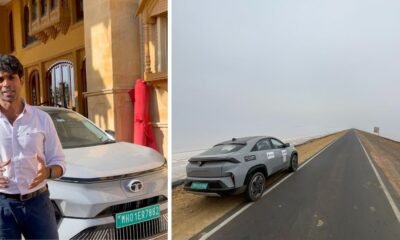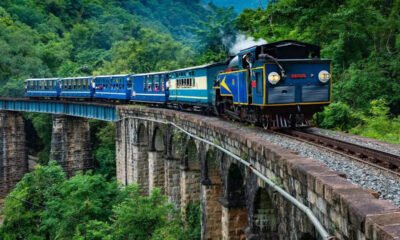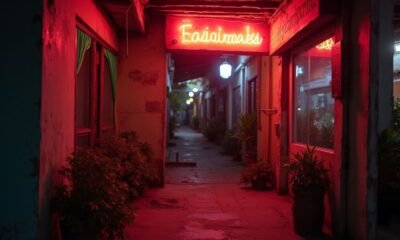Travel Guides & Articles
Sustainable Homestay in Dharamshala Built with Mud and Bamboo

Tucked away in the mountains of Dharamshala, where mobile networks waver and concrete retreats give way to pine forests and terraced fields, sits a homestay unlike most others; not simply for what it offers guests, but for what it refuses to compromise on.
Kosen Rufu Village Recluse is not the kind of place you stumble upon. To reach it, you have to leave your car behind and walk a stretch of narrow path that cuts through the slopes of Thathri village. There are no neon boards or manicured driveways here, only a cluster of mud and slate cottages rising gently from the earth, as though they’ve always belonged.
But this isn’t a place frozen in tradition. It’s a retreat shaped with intention, a quiet rebellion against the pace and practices of mainstream tourism. Built almost entirely from handmade bricks, bamboo, and slate, Kosen Rufu is the result of years of labour, a deep personal calling, and the guidance of one of India’s most revered eco-architects, Delia Kinzinger — known to many as Didi Contractor.
Advertisement
Building in the lap of nature
The homestay, as it stands today, began as a piece of difficult terrain. It was constructed on a patch of land in Thathri, off Khanyara Road in Dharamshala, bought in 2018 by filmmaker Raman Siddhartha. The idea, he says, was never about just building a stay.
“I’ve lived in London for 25 years, but I was born in Himachal. My father, a bureaucrat, took me to remote villages all the time. I grew up seeing ‘kachcha makaan’ (mud homes) that were deeply rooted in the land and community,” Raman says. “That never left me. It stayed in my subconscious that if I ever returned, I would build a mud house.”
Returning to India with his wife and creative partner Manju Narayan in 2016, the couple initially explored the region as filmmakers. But the growing clutter of concrete homes, even in remote Himalayan corners, deeply unsettled them.
“Everyone was in a rush to ‘develop’,” Manju says. “Concrete everywhere. It felt like we were losing the soul of the land.”
The couple’s decision to build an entirely sustainable home and eventually, a homestay, began as a personal project. But soon, the scale and significance of what they were creating outgrew that scope.
Didi Contractor’s architecture of resistance
To bring their vision to life, Raman and Manju reached out to Delia Kinzinger, the German-American architect better known in the region as Didi Contractor. Based in Dharamshala, Kinzinger had already spent decades building eco-sensitive homes that honoured local traditions and terrain.
Advertisement
She was, by all accounts, uncompromising. “She refused to use AutoCAD,” Raman says. “Every sketch was hand-drawn. Every angle was measured by instinct and wisdom.”
The late architect had her doubts initially. But the project’s intention, sincerity, and the couple’s desire to reconnect to their roots eventually won her over. Her involvement changed everything.
The structures at Kosen Rufu were designed using mud bricks made from earth sourced locally, dried and shaped by hand. “Drying them was a challenge,” Raman admits. “The mountain weather is unpredictable. Many bricks were washed away by sudden rain.”
A long walk to sustainability
Despite setbacks, they never resorted to cement. The foundation used bamboo, walls were packed with stone and mud, and even the roofing slate was locally quarried. No industrial material was brought in. The design incorporated 18-inch thick walls, natural insulation using pine needles and dust, and multi-layered mud coatings that mimicked the strength of concrete — without the environmental cost.
The construction for this homestay began in 2019 and spanned nearly four years. With no road access at the time, every material, from bricks to bedding, had to be transported by mules. “Friends and family called us mad,” Raman laughs. “They said this was a foolish thing to do. But we were clear, we didn’t want to disturb the land.”
In fact, the path to the retreat remains intentionally non-motorable. Cars stop some distance away; the rest must be walked. “This was Didi ma’am’s principle,” he says. “The home should adapt to the land, not the other way around.”
Advertisement
Today, a small road exists, thanks in part to the couple’s efforts with local authorities. And the road is primarily not for tourists, but to help the villagers in nearby homes access emergency care more easily.
From hostility to harmony
At first, not everyone in Thathri was convinced. “People filed complaints against us,” Manju recalls. “They couldn’t understand why anyone would build a mud house willingly; it was seen as something the poor do out of necessity.”
Every beam, every brick at Kosen Rufu Village Recluse holds a story, not just of resistance to mainstream tourism, but of radical care for the land. One person who oversaw this careful dance between terrain and technique was the chief architect Naresh Sharma, who worked closely with both the founders and Delia Kinzinger to bring the retreat to life.
“This wasn’t a copy-paste project,” Naresh says. “In the mountains, you can’t force your ideas on the land. You have to read the slope, feel the weather, and understand how wind moves through the valley. Only then can you build something that lasts, not just physically, but spiritually too.”
But time and tea heal most things. As the couple integrated with village life, attending weddings, sharing meals, and participating in festivals, their intentions became clearer. “Now, we’re seen as part of the community,” Manju says. “And more importantly, the locals are starting to see value in their traditional homes again.”
That, perhaps, is the most lasting impact of Kosen Rufu; it doesn’t just welcome visitors, it encourages local preservation. The couple now advises villagers not to tear down their ancestral homes and is considering hosting community workshops on sustainable construction.
Advertisement
A stay that teaches you to slow down
The retreat’s name, ‘Kosen Rufu’, is a Japanese phrase meaning ‘peace and happiness’ — a reflection of the couple’s Buddhist practice. True to its name, the homestay offers little by way of luxury as conventionally defined. There are no TVs, no air conditioning, and often, no mobile signal.
Instead, guests find mud cottages warmed by the sun, the scent of pine wood, and views that stretch beyond the folds of the mountains. “We had no scaffolding like you’d see in cities. Most of the work was done by local artisans using traditional tools. It was a collective memory — something modern design has almost forgotten,” Naresh mentions.
“People come here and at first, they’re unsettled by the quiet,” says Manju. “But by the end, they don’t want to leave.”
Rooms and huts start at ₹3,000 per night, with varying tariffs depending on accommodation type. Each space is equipped with chemical-free bedding, eco-friendly toiletries, and locally-made linens. Plastic is banned on the premises.
Even the water tanks are made from double-insulated steel, avoiding plastic and helping regulate water temperature, which is critical during winter months when freezing is a risk.
But beyond materials and methods, the retreat’s hospitality stands out. “We’ve trained our staff to offer tea and water to anyone who walks in, even if they’re not guests,” says Manju. “It’s about creating a space that feels like home.” Local women and youth are employed as caretakers and guides, creating livelihood opportunities in the region while preserving cultural ties.
Advertisement
“Staying here was a refresher from the crazy city life. My family loved every bit of it. And the food is really delicious and fresh here,” says Aditya Kumar, a software developer who visited the property with his family.
The recluse has also found its place in the heart of celebrated actor and poet Piyush Mishra. “During one of his recent visits to Kosen Rufu, Mishra shared his happiness, attributing to the peace and quiet the stay gave him in contrast to the ignorant and egoistic world he’s come from,” Raman mentions.
What sustainability costs and saves
Building a retreat of this kind wasn’t cheap. “We went nearly 30% over budget from our planned ₹2–2.5 crore,” Raman says. “But we never considered cutting corners.” And yet, the investment has paid off, not just in guest satisfaction, but in minimal maintenance.
Thanks to Didi Contractor’s construction techniques, the mud walls are resilient through the seasons. The natural plasters used, involving pine needles and multiple binding layers, have kept out seepage and cracks. “We haven’t had to spend on repairs the way you would with concrete homes,” Raman explains.
The real saving, though, lies in preserving the terrain. By not flattening land or using heavy equipment, the retreat has avoided the kind of erosion and drainage issues that plague many mountain resorts.
Looking ahead and expanding with caution
As interest in the homestay grows, the couple is considering adding a few more mud cottages to the compound. But expansion will be slow and in line with the core philosophy.
“We’re not here to scale like a chain,” Raman says. “The idea is to deepen, not widen.”
What they do hope to grow is community engagement by helping more people understand that sustainability isn’t about aesthetics, but ethics. “It’s not just how you build,” Manju adds. “It’s how you live.”
Kosen Rufu Village Recluse is not a prototype for mass tourism, and perhaps that is its greatest strength. It refuses replication. It asks instead for a reflection of what it means to belong to a place, to build with respect, and to host with humility.
The retreat is not just about living closer to nature, but about learning how to live without harming it. It doesn’t lecture, it invites.
As Manju Narayan puts it: “We’re not just offering a bed and a view. We’re asking people to experience the value of the land, the culture, and the pace of life we’ve forgotten.”
For those who arrive with hurried feet and cluttered minds, the quiet of Kosen Rufu doesn’t fill a void, but it reminds you it was never meant to be filled with noise. In a world fast losing its grounding, this little homestay on the slope of Thathri holds its ground not by standing tall, but by sinking its roots deeper into the soil.
Travel Guides & Articles
Indian women trafficked to Malaysia on visa-free entry for domestic work

CHANDIGARH: It is not only Gulf countries where women from India, who had gone there on the pretext of a job offer, got trapped; Malaysia has now become the new destination.
Women, especially from Tamil Nadu, Telangana, Andhra Pradesh, Punjab, Kerala and Uttar Pradesh, are being taken to this Southeast Asian nation with promises of legitimate domestic work. Travel agents use the visa-free entry route to lure them, after which they are forced to live and work in conditions described as unstable and precarious.
In an advisory issued on September 9 this year, the High Commission of India, Kuala Lumpur (Labour Wing), in a document titled “Indian nationals getting stranded in Malaysia”, a copy of which is with this newspaper, stated: “The majority of the affected individuals are unskilled/semi-skilled labourers and hail from several states in India including Tamil Nadu, Telangana, Andhra Pradesh, Punjab, Kerala and Uttar Pradesh. They are invariably misled with false promises of employment by unscrupulous agents in India and Malaysia.”
“The following issues of concern came to the notice of the High Commission: Indian nationals travelling under the pretext of tourism but intending to look for employment are often denied entry on arrival. Those who manage to enter the country often overstay beyond 30 days and are thus declared ‘illegal’. Entry is also refused to those Indian nationals who are genuine tourists but fail to provide valid documentation, including return tickets, proof of accommodation, and financial means,” it stated.
It further read: “It has been observed that unscrupulous agents in India and Malaysia entice a number of Indian nationals with prospects of employment and arrange their travel to Malaysia on the pretext of tourism to get visa-free entry and stay for 30 days in Malaysia. Such individuals become illegal after expiry of 30 days and are thus vulnerable to various forms of exploitation locally. They are also subjected to detention, imprisonment and associated legal actions by Malaysian enforcement agencies.”
The High Commission of India, Kuala Lumpur has further advised all State Governments, Protectors of Emigrants (PoE) and immigration officers to issue public advisories and exercise strict scrutiny of Indian nationals, especially ECR passport holders, departing to Malaysia from international airports including Trichy, Chennai, Hyderabad, Kolkata, Cochin, Bengaluru and Amritsar.
It has also been stated that passengers deceived by agents should be encouraged to provide full details of such agents, and that information may be compiled and shared with state and central government authorities for appropriate action.
Travel Guides & Articles
Chandigarh unveils master plan for tourism growth

The Chandigarh Administration has prepared a comprehensive master plan to boost tourism by integrating cultural circuits that connect heritage landmarks, natural attractions, and modern sites. The initiative aims to offer visitors a complete tourism experience while enhancing the city’s profile as both a cultural and modern destination.
According to Tourism Department officials, infrastructure upgrades are already underway. Iconic attractions such as the Rock Garden and city gardens are being modernised with improved facilities. A digital museum at the Le Corbusier Centre is also in development to showcase the city’s rich architectural legacy and modernist design heritage.
The plan emphasises eco-tourism and cultural tourism as major focus areas. Activities like trekking, boating, and cycling will be promoted alongside lake tourism and green spaces. Festivals, exhibitions, and cultural performances will be used to highlight the city’s vibrant artistic and cultural identity, enriching visitor experiences and community engagement.
Officials stated that these projects will not only improve visitor satisfaction but also position Chandigarh as a balanced blend of heritage and modernity. By promoting sustainable and eco-friendly tourism, the initiative aims to create long-term economic opportunities while maintaining the city’s unique identity envisioned by Le Corbusier.
Despite its popularity among domestic travellers, Chandigarh attracts relatively fewer foreign tourists. Ministry of Tourism data shows that while lakhs of Indian visitors arrive annually, foreign arrivals remain limited. In 2019, the city welcomed 15.63 lakh domestic tourists but only 44,132 foreigners, and numbers dropped drastically during the pandemic years.
Tourism is now rebounding, with 2024 recording nearly 10 lakh domestic visitors and 39,058 foreigners — the highest foreign arrivals since the pandemic. With the new master plan under schemes such as Swadesh Darshan, the Administration hopes to scale up both domestic and international tourism, ensuring Chandigarh becomes a leading urban destination in India.
Travel Guides & Articles
Air India adopts SITA tools for sustainability

With rising fuel prices and increasing global pressure to reduce carbon emissions, airlines are under constant demand to improve efficiency. Air India Group is taking proactive measures by adopting SITA OptiFlight and SITA eWAS, two cutting-edge digital solutions designed to optimise flight operations. This marks a significant milestone in the airline’s ongoing modernisation journey.
The rollout covers Air India’s Airbus A320 and Air India Express Boeing 737 fleets, operating across both domestic and international routes. Deployment for the widebody fleet is also planned in the near future. By leveraging these technologies, Air India expects to cut carbon emissions by nearly 35,000 tons annually, contributing directly to its sustainability goals.
SITA OptiFlight is a suite of intelligence tools that optimise critical phases of flight. At its center is OptiClimb, a climb optimisation solution that uses historical flight data, aircraft-specific models, and weather forecasts to generate tailored climb profiles. This enables pilots to cut fuel consumption during the most energy-intensive stage of flight while maintaining performance and safety.
SITA eWAS complements this by providing pilots with real-time weather updates and predictive forecasting. Equipped with this tool, crews can avoid turbulence, re-route more effectively, and make smarter in-flight decisions. Together, these systems empower pilots with actionable data that improves efficiency while supporting Air India’s environmental commitments.
Industry experts highlight this move as a strong example of how airlines can balance regulatory pressures with operational needs. Sumesh Patel, President, Asia Pacific at SITA, stated that predictive solutions like OptiFlight® and eWAS demonstrate how digital innovation can cut emissions, save fuel, and unlock real operational value.
Echoing this sentiment, Basil Kwauk, Chief Operations Officer at Air India, emphasised that sustainability and efficiency remain at the core of the airline’s transformation into a world-class carrier. By integrating advanced tools into daily operations, Air India is not only reducing its carbon footprint but also aligning itself with the global drive towards greener aviation.
-

 Business2 weeks ago
Business2 weeks agoThe Guardian view on Trump and the Fed: independence is no substitute for accountability | Editorial
-
Tools & Platforms1 month ago
Building Trust in Military AI Starts with Opening the Black Box – War on the Rocks
-

 Ethics & Policy2 months ago
Ethics & Policy2 months agoSDAIA Supports Saudi Arabia’s Leadership in Shaping Global AI Ethics, Policy, and Research – وكالة الأنباء السعودية
-

 Events & Conferences4 months ago
Events & Conferences4 months agoJourney to 1000 models: Scaling Instagram’s recommendation system
-

 Jobs & Careers3 months ago
Jobs & Careers3 months agoMumbai-based Perplexity Alternative Has 60k+ Users Without Funding
-

 Podcasts & Talks2 months ago
Podcasts & Talks2 months agoHappy 4th of July! 🎆 Made with Veo 3 in Gemini
-

 Education2 months ago
Education2 months agoVEX Robotics launches AI-powered classroom robotics system
-

 Education2 months ago
Education2 months agoMacron says UK and France have duty to tackle illegal migration ‘with humanity, solidarity and firmness’ – UK politics live | Politics
-

 Podcasts & Talks2 months ago
Podcasts & Talks2 months agoOpenAI 🤝 @teamganassi
-

 Funding & Business3 months ago
Funding & Business3 months agoKayak and Expedia race to build AI travel agents that turn social posts into itineraries













